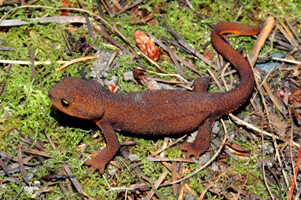In contrast to most salamanders, newts are often active in the daytime, on land, in the open. The bodies of newts contain toxins that protect them from predators. Handling newts is safe, but eating them or their skin secretions is not.
Photo Credit: Geoffrey A. Hammerson
Taricha granulosa
Common Name: rough-skinned newt
Other Common Names: roughskin newt
Animal Guild: Amphibian
Class > Order > Family: Amphibia > Caudata > Salamandridae
What does the species look like?
Adults: Adults typically have rough skin, except breeding males. Their back is usually dark to light brown, sometimes with dark blotches, and their underside is usually yellow to reddish-orange. They generally have dark pigment on their lower eyelids and beneath their eyes, which are relatively small. They can reach up to 3.5 inches (9 cm) in length.
Breeding males: Breeding males have smooth skin, a highly flattened tail, and dark skin on the undersides of their feet.
Large larvae: Larvae have large gills, a tall tail fin that extends to the shoulder area, and a row of light spots on each side of their back. Their belly is sometimes pink or orange. Larvae can reach up to 3 inches (7.5 cm) in total length.
Eggs: Females generally attach eggs singly (not in clumps) to objects in quiet water. Eggs and embryos move freely in a jelly capsule that is 0.1 to 0.2 inches (3-4 mm) in diameter.
Where is the species found?
States & Provinces
AK, BC, CA, ID, MT, OR, WA
Distribution
The range includes the Pacific coast of North America from southeastern Alaska to Santa Cruz County, California. Records from the Rocky Mountains in Idaho and Montana could represent introductions. The elevational range extends from sea level to about 9,200 feet.
Rough-skinned newts inhabit various wooded and open valley habitats near lakes, reservoirs, ponds, or stream pools. They generally spend most of their lives on land, but in some areas, adults may live in the water throughout the year or during the dry season.
General Phenology and Life History
The timing of breeding varies greatly, depending on location and conditions. In many areas, newts migrate to water to breed and lay eggs in late fall, winter, or spring. The resulting larvae metamorphose several months later in summer or fall. At higher elevations in the mountains, rough-skinned newts might breed in summer or early fall, and larvae might metamorphose about a year later. Adults can travel up to several hundred meters (or several hundred yards) from their land-based habitat and the water where they breed. As is true of many other land-dwelling amphibians, newts are inactive during freezing weather or periods of drought.
Special Considerations for Observing
Which phenophases should I observe?
Do you see/hear...?
Activity
Adults on land More...
For abundance, enter the number of individual animals observed in this phenophase.
Adults in water More...
For abundance, enter the number of individual animals observed in this phenophase.
Adults feeding For abundance, enter the number of individual animals observed in this phenophase.
Reproduction
Mating For abundance, enter the number of individual animals observed in this phenophase.
Fresh eggs For abundance, enter the number of individual animals observed in this phenophase.
Development
Dead adults For abundance, enter the number of individual animals observed in this phenophase.
What do these phenophases look like?
There is currently no photoguide available for this species. If you'd like help us create one, use the guidance document and species template provided here . Then send it via email to education@usanpn.org when it is complete.
